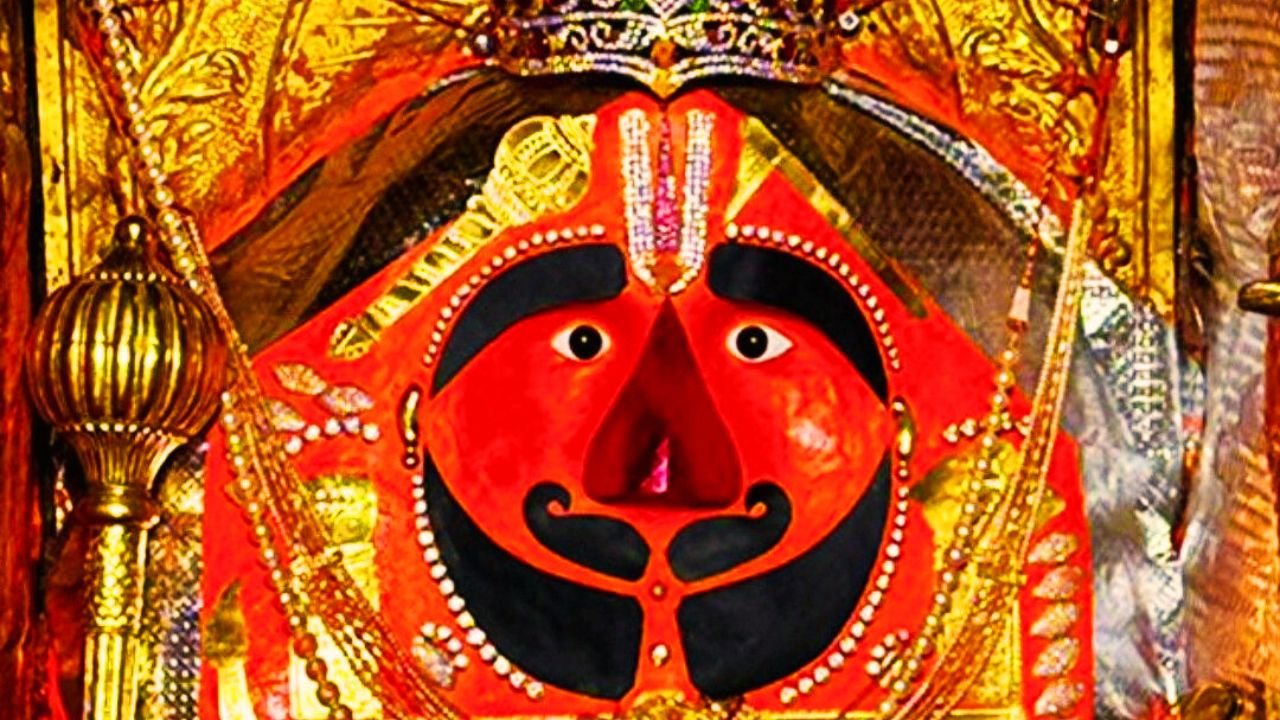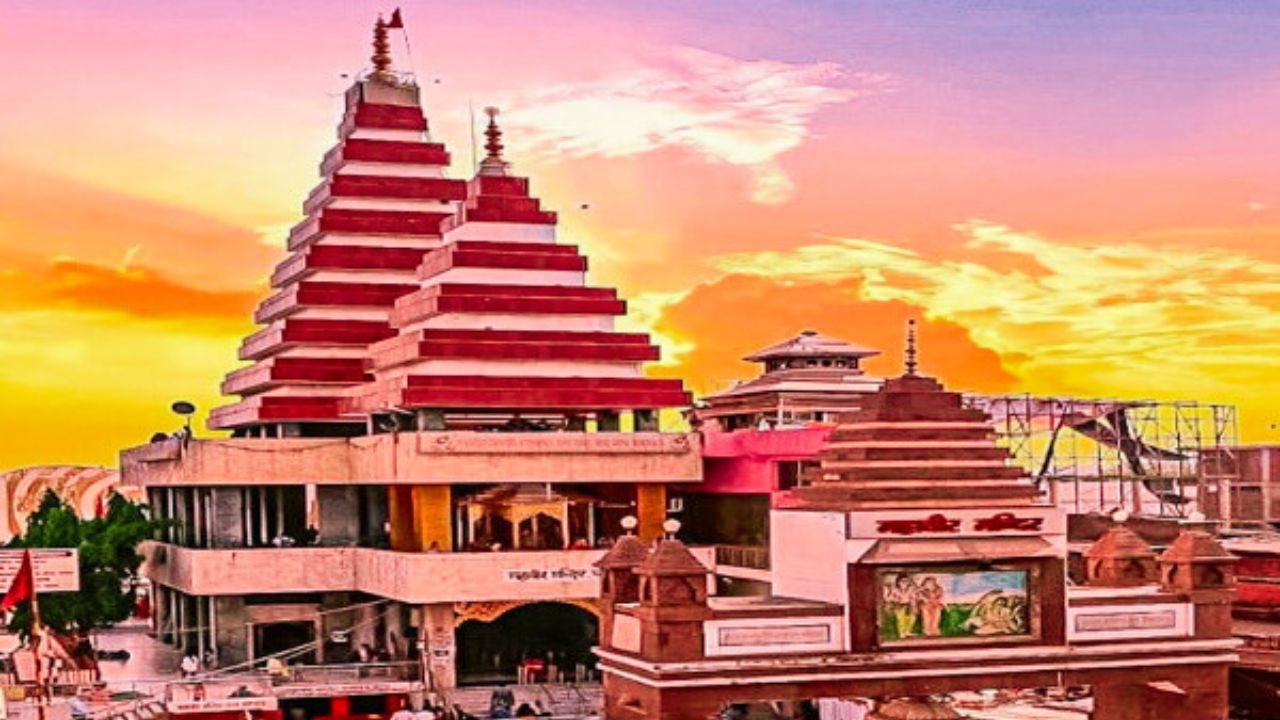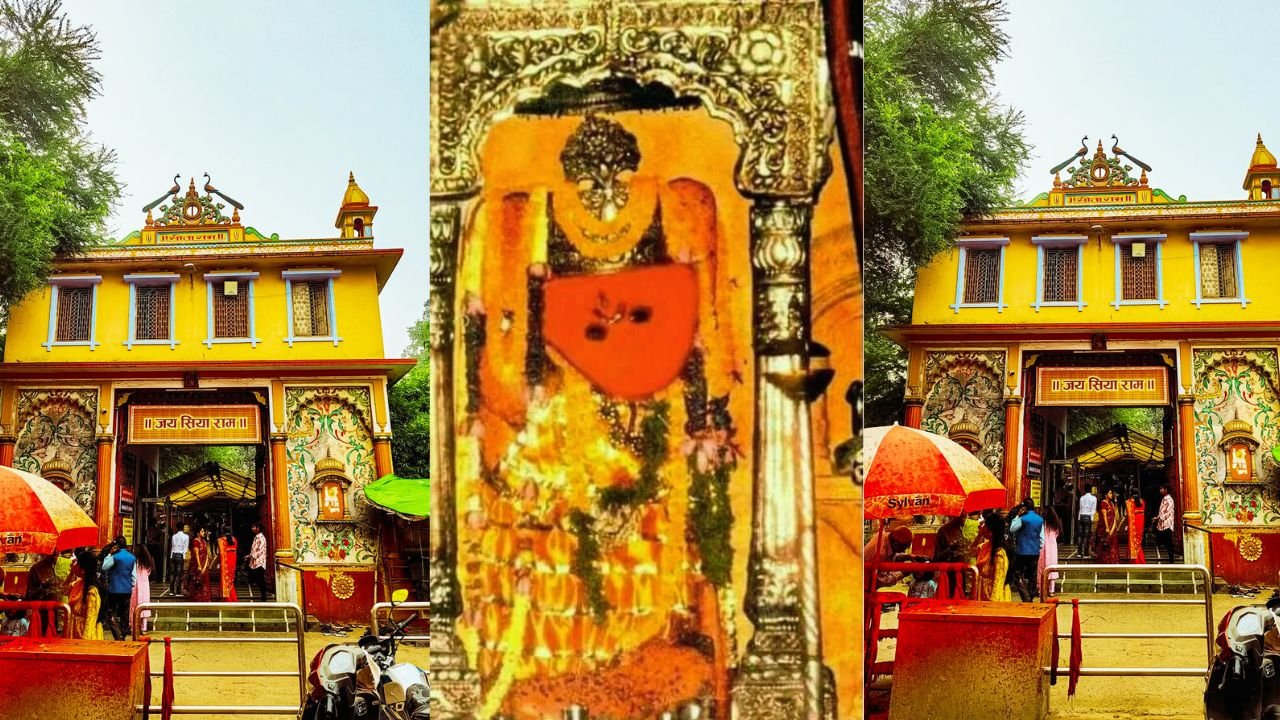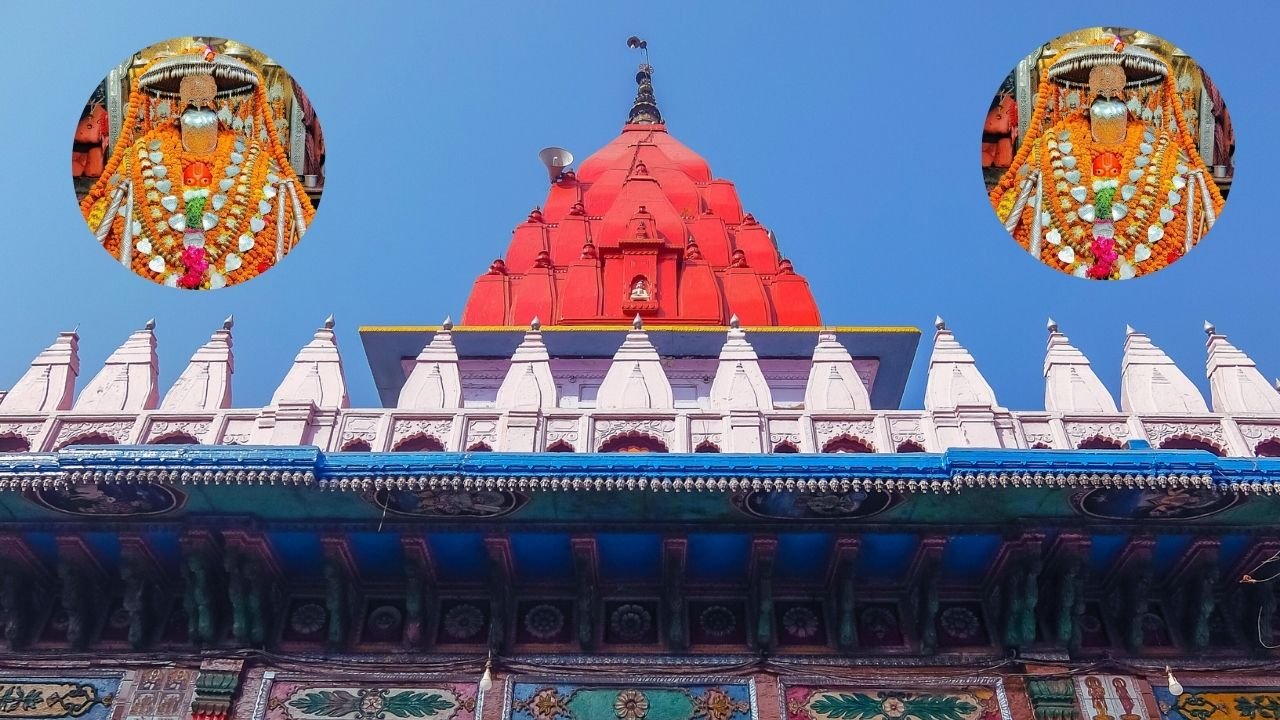Salasar Balaji is in the heart of Rajasthan. It’s a special place for Hanuman devotees. Here, you can see a stunning Hanuman temple and enjoy lively festivals. It’s a top spot for those interested in Rajasthan tourism.
Salasar Balaji draws visitors from everywhere. It shows the deep cultural value and importance of the Hanuman temple in Rajasthan tourism.
Salasar Balaji Temple is a famous Hindu pilgrimage site located in the Churu district of Rajasthan. It attracts thousands of devotees every year, especially on Chaitra Purnima and Ashvin Purnima when grand fairs are organized. The temple is known for fulfilling wishes and is considered a center of devotion for Hanuman Bhakts.
The temple’s architecture is breathtaking, and its history is rich. Salasar Balaji is perfect for those looking for a spiritual journey. It’s a key part of Rajasthan tourism and a famous Hanuman temple.
The Legend and Significance of Salasar Balaji Temple
The Salasar Balaji history is filled with devotion and spiritual growth. At its core is the temple’s origin, tied to a self-manifested Hanuman idol. This idol’s discovery started the temple’s construction.
The temple’s history shows significant growth over the years. The self-manifested idol is a sacred symbol, attracting devotees worldwide. Its presence shows the power of faith and devotion, inspiring visitors today.
The Story Behind the Temple
The Salasar Balaji Temple is associated with a fascinating legend. It is believed that in the 18th century, a farmer in the village of Asota in Rajasthan found an idol of Lord Hanuman while plowing his field. The idol was brought to Salasar, where it was installed in a temple. Over time, the temple gained fame for its miraculous powers, and devotees began flocking to seek blessings from Lord Hanuman, who is affectionately called “Balaji” here.
The temple is also closely associated with the famous shrine of Khatu Shyamji, another revered deity in Rajasthan. Many devotees visit both temples as part of their pilgrimage.
Spiritual Importance
Salasar Balaji Temple is considered one of the most powerful Hanuman temples in India. It is believed that praying here can fulfill wishes, remove obstacles, and bring peace and prosperity to devotees. The temple is especially crowded on Tuesdays and Saturdays, days considered auspicious for worshipping Lord Hanuman.
The Architecture of Salasar Balaji Temple
The Salasar Balaji complex is famous for its stunning temple architecture. It combines traditional and modern styles beautifully. The intricate carvings and ornate decorations on the walls and ceilings show the designers’ skill.
At the complex’s heart is the main temple, a perfect example of shrine design. It stands out as a masterpiece of temple architecture. The surrounding shrines, dedicated to various deities, also showcase beautiful designs and intricate carvings.
Temple Structure
The Salasar Balaji Temple is a beautiful example of Rajasthani temple architecture. The temple complex is spacious and well-maintained, with intricate carvings and designs adorning its walls. The main shrine houses the idol of Lord Hanuman, which is adorned with a golden crown and jewelry.
Idol of Lord Hanuman
The idol of Lord Hanuman at Salasar Balaji is unique and radiates a sense of calm and power. Devotees believe that the idol is self-manifested (Swayambhu) and possesses divine energy. The idol is depicted in a standing posture, holding a mace (gada) in one hand and a mountain in the other, symbolizing strength and devotion.
Temple Complex
The temple complex also includes smaller shrines dedicated to other deities, such as Lord Rama, Goddess Sita, and Lord Lakshmana. The peaceful atmosphere and the spiritual energy of the temple make it a perfect place for meditation and prayer.
Rituals and Festivals at Salasar Balaji Temple
The Salasar Balaji temple is famous for its spiritual power and religious significance. It draws devotees from all over the country. This Hanuman temple is known for its special energy, leading to deep spiritual experiences for many.
The temple’s religious significance comes from its role in Hindu mythology. It’s also known for its rituals and practices. It stands as a symbol of faith and devotion, offering peace and solace to visitors.
Visitors can feel the spiritual power of the Hanuman temple by joining in rituals like prayer and meditation. The temple’s religious significance shows the lasting power of faith and devotion.
Visitors can also join in on spiritual activities and events. These include prayer ceremonies and cultural festivals. The hanuman temple complex is a must-see for anyone interested in India’s cultural and religious heritage.
The spiritual power of the Salasar Balaji temple inspires and guides many. Its religious significance continues to draw devotees from far and wide. Whether you’re a devoted Hanuman follower or seeking a divine connection, the Salasar Balaji temple is a place you must see.
Daily Rituals
The temple is open from 5:00 AM to 10:00 PM, and the day begins with the morning aarti (prayer ceremony). Devotees often recite the Hanuman Chalisa, a hymn dedicated to Hanuman, and offer sindoor (vermilion) and laddoos (sweet offerings) to seek his blessings. The evening aarti is equally special, with the temple illuminated by lamps and the air filled with devotional songs.
The daily rituals and worship practices at Salasar Balaji temple are key to its spiritual life. The temple has a strict temple routine. This includes various pujas, aartis, and other rituals all day long. These worship practices help build a sense of community and devotion among the devotees.
Important daily rituals include the morning puja at sunrise and the evening aarti at sunset. The temple also has special pujas and rituals on Tuesdays and Saturdays. These days are seen as auspicious for worship.
- Morning puja: performed at sunrise
- Evening aarti: performed at sunset
- Special pujas: offered on Tuesdays and Saturdays
These daily rituals and worship practices are central to the temple’s spiritual tradition. They aim to foster devotion and community among the devotees. By following the temple routine, devotees can feel a deeper connection with the divine and with one another.
Festivals
The temple is a hub of activity during major Hindu festivals, especially Hanuman Jayanti, which celebrates the birth of Lord Hanuman. During this time, the temple is beautifully decorated, and the atmosphere is filled with devotional songs, chants, and the ringing of bells. Other festivals like Ram Navami and Diwali are also celebrated with great enthusiasm.
Salasar Balaji temple is famous for its lively religious festivals. These festivals draw in thousands of people. The temple’s calendar is packed with events that highlight the importance of temple celebrations for devotees.
The Hanuman Jayanti is a big event here. It celebrates Lord Hanuman’s birthday. The festival features grand processions, devotional songs, and offerings to the deity.
Hanuman Jayanti Celebrations
The Hanuman Jayanti at Salasar Balaji is truly special. The temple is decorated with bright colors. Devotees come together to sing hymns and pray to Lord Hanuman.
Monthly Amavasya Gatherings
Every month, the temple holds Amavasya gatherings. Devotees come to worship and seek blessings. These gatherings are a big part of the temple’s religious festivals. People from all over the country attend.
Annual Mela Events
The temple also hosts annual mela events. These are grand fairs that show off the region’s culture. They highlight the importance of temple celebrations in bringing people together.
Some key highlights of the temple’s festival calendar include:
- Hanuman Jayanti processions
- Monthly Amavasya gatherings
- Annual mela events
How to Reach Salasar Balaji Temple
Salasar Balaji temple is in the Churu district of Rajasthan. It’s a key spot for Rajasthan tourism. Roads and rails connect it to nearby cities like Jaipur and Delhi. This makes it easy for people to visit.
Visitors can take a train to Salasar’s railway station. Then, they can get a taxi or bus to the temple location. It’s also reachable by car or bus from Jaipur and Delhi.
By Air
- The nearest airport is Jaipur International Airport (JAI), about 170 km from Salasar.
- From Jaipur, you can hire a taxi or take a bus to reach the temple.
By Train
- The nearest railway stations are:
- Sujangarh Railway Station (25 km)
- Didwana Railway Station (45 km)
- Jaipur Railway Station (170 km)
- From these stations, taxis and buses are available.
By Road
- Salasar is well connected by road with major cities:
- Jaipur – 170 km
- Delhi – 330 km
- Bikaner – 160 km
- Jodhpur – 210 km
- Regular buses operate from Jaipur, Delhi, and Bikaner.
- Private taxis and rental cars are also available.
Tips for Visitors
-
Timings: The temple is open from 5:00 AM to 10:00 PM. Early morning and evening aarti are particularly special.
-
Dress Code: Modest clothing is recommended, as the temple is a place of worship.
-
Footwear: Remove footwear before entering the temple premises.
-
Offerings: Devotees often offer sindoor, laddoos, and flowers to Lord Hanuman.
-
Photography: Check with temple authorities; some areas may restrict photography.
-
Best Time to Visit: The winter months (October to March) are ideal for visiting, as the weather is pleasant.
Major Attractions at Salasar Balaji Temple
1. The Main Shrine
- The idol of Salasar Balaji is self-manifested (Swayambhu) and has unique features like a round face, beard, and mustache.
2. Swayambhu Hawan Kund
- A sacred fire (havan) that has been burning continuously for several years, believed to fulfill wishes.
3. Akhand Jyoti (Eternal Flame)
- This divine flame is said to be burning for centuries and holds immense spiritual significance.
4. Mohandas Ji’s Samadhi
- Dedicated to Saint Mohandas, who first discovered the idol of Hanumanji in 1754.
5. Rani Sati Dadi Temple (Near Salasar)
- A significant pilgrimage site dedicated to Goddess Dadi Rani Sati.
Nearby Attractions
| Attraction | Distance from Salasar Balaji Temple |
|---|---|
| Khatu Shyamji Temple | 45 km |
| Rani Sati Temple | 50 km |
| Sikar | 60 km |
| Jaipur | 160 km |
| Bikaner | 200 km |
Frequently Asked Questions (FAQs)
| Question | Answer |
|---|---|
| Is there an entry fee? | No, entry to the temple is free for all visitors. |
| How long does it take to explore? | 1-2 hours, depending on the crowd and your pace. |
| Are there facilities for tourists? | Yes, basic facilities like restrooms and drinking water are available. |
| Can non-Hindus visit? | Yes, the temple is open to people of all faiths. |
| Is photography allowed? | Check with temple authorities; some areas may restrict photography. |
Conclusion-Final Thoughts
Our journey through Salasar Balaji temple shows its eternal spirit. This place has a long history, touching many lives. It’s a place of solace, strength, and inspiration for all who visit.
The temple’s idol of Lord Hanuman is a symbol of divine presence. It reminds us of the power of strong belief. People from everywhere come here, seeking blessings and a closer bond with the divine.
The temple’s festivals, like Hanuman Jayanti, add to its cultural and spiritual importance. These events bring people together, creating a sense of community and joy.
The temple’s impact keeps growing, touching hearts worldwide. Salasar Balaji is a beacon of faith, guiding those seeking spiritual growth and peace.
Salasar Balaji Temple is more than just a place of worship; it’s a symbol of faith, devotion, and the miraculous powers of Lord Hanuman. Whether you’re a spiritual seeker, a history enthusiast, or simply a curious traveler, this temple offers something for everyone. The peaceful atmosphere, the stunning architecture, and the divine energy of the temple make it a truly special place.
As you stand before the idol of Lord Hanuman, you’ll feel a sense of peace and connection with the divine. A visit to Salasar Balaji Temple is not just a journey to a sacred site but also a journey within, where faith and devotion come alive.
So, when you’re in Rajasthan, don’t miss the chance to visit Salasar Balaji Temple. Let the blessings of Lord Hanuman guide you, and may your visit fill your heart with strength, courage, and peace. Jai Hanuman!
Would you like recommendations for tour packages or more travel details? 😊




